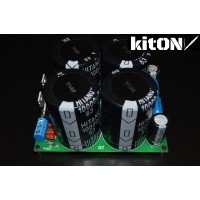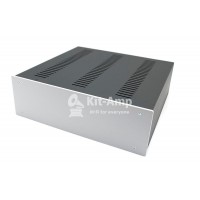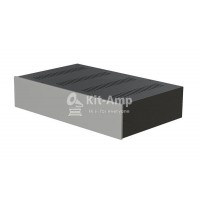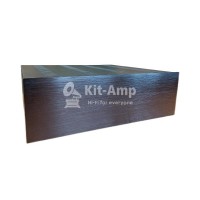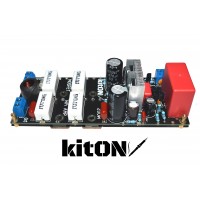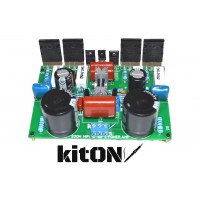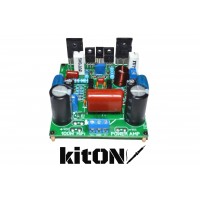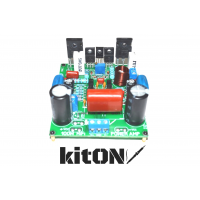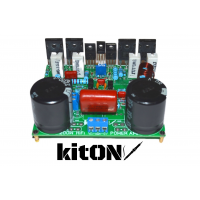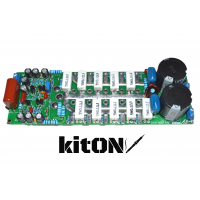It should also be noted the undoubted advantages of field-effect transistors over bipolar ones:
1. PT can withstand noticeably large impulse loads, or rather overloads.
2. The absence of input currents, in some cases, makes it possible to significantly simplify the swinging cascades.
3. The parameters are less dependent on temperature, besides they have a large linear section of the transfer characteristic.
The amplifier is assembled on 2 pairs of quasi-complementary output transistors IRFP250N (Dismantling) with asymmetric preliminary stages, the module is also equipped with a thermal stabilization and quiescent current control circuit.
When using 8 ohm acoustics, the supply voltage can be raised to 55-60V to obtain the equivalent power at 4 ohms.
The module is easy to set up and requires only setting the quiescent current, depending on the supply voltage. The optimal quiescent current of the output stage is 60-120mA, which is approximately equal to 100-200mA for the power supply of the module as a whole. To adjust the quiescent current, the input is shorted, the load is turned off, the ammeter is turned on in the gap of one of the supply arms and the required value is set using a trimming resistor on the board, after which a pause of 5-10 minutes is needed. to warm up the radiator. You should focus on the acceptable temperature of the radiator (+ margin for a closed case).
For passive cooling at a supply voltage close to the maximum, a radiator of at least 1500 sq. cm is required
Subjectively, the amplifier pleased with the sound quality, can be used for any acoustics, including subwoofers, suitable in terms of power parameters and considered as an alternative to amplifiers on microcircuits.
The module can be recommended for building a high-quality high-power amplifier, as well as for getting acquainted with field-effect transistors at the output.
| Measurements | |
| Supply voltage bipolar | -52V...0...+52V |
| Load resistance | 4 Ohm |
| Power maximum, W | 204 |
| Testing power, W | 150 |
| Quiescent current | 150mA |
| Frequency response (from 40 Hz to 15 kHz), dB | +0.02, -0.12 |
| Noise level, dB (A) | -107,9 |
| Dynamic range, dB (A) | 108,0 |
| THD, % | 0,0210 |
| THD + Noise, dB (A) | -70,9 |
| IMD + Noise, % | 0,0150 |
| IMD at 10 kHz, % | 0,1370 |
| Measurement Page | |
| General characteristics | |
| Amplifier class | AB |
| Maximum supply voltage (bipolar / constant) DC | 50V |
| Minimum supply voltage (bipolar / constant) DC | 25V |
| Module size LxWxH, mm | 90x100x35 |
| Number of channels | mono |
| Output transistors | IRFP250N |
| Weight, kg | 0,164 |
Related Products
Tone control LF / MF / HF / Volume
Tone control / pre-amplifier with volume / treble / midrange / bass control.Tone control block is bu..
670.00грн.
Subwoofer filter with PSU
Active subwoofer filter, used to cut off the midrange and treble component from the common signal an..
530.00грн.
ALPS rk27, 100K volume control, with switchable loudness
High-quality Chinese replica of the famous Japanese volume control ALPS rk27, 100K with elements of ..
1,060.00грн.
LED Signal Strength Indicator, 10 LEDs
Signal strength indicator with a logarithmic scale on the LM3915 chip. The main difference between t..
210.00грн.
Amplifier power supply up to +/- 63V
Universal board of a bipolar power supply for the power amplifier.Ideal for chips like TDA2030A / TD..
1,460.00грн.
Toroidal transformer 474W
474W-220V / 2 x 0-20V-25V-35V x 6A, 2x15Vx1A, 12Vx2A, screen, cotton tape + surface treatment, washe..
2,960.00грн.
Toroidal transformer 790W
790W 220V / 0-28V-35V-46V x 8A, 0-28V-35V-46V x 8A, 2x15Vx1A, 12Vx2A, winding screen, Cotton tape + ..
3,840.00грн.
Enclosure MB-21ECU (Black) W320-H100-L310
Universal metal housing for electronics (REA).The body is made of steel. The front panel is made of ..
2,073.00грн.
Enclosure MB-29ECU(Black) W364-H65-L340 Brushed-Aluminum
"Metal case, model MB-29 (Silver).Universal metal housing for radio electronics (REA).The body is ma..
2,564.00грн.
Enclosure MB-31ECU (Black) W420-H90-L260
A new generation of cases with an aluminum panel.The main difference from the previous generation is..
0.00грн.
Tone control TDA1524
Volume, balance and tone control on a specialized chip TDA1524A.The TDA1524A chip is a two-channel (..
430.00грн.
Enclosure MB-26ECU(Black) W430-H132-L387 Brushed-Aluminum-Black
The body is metal, model MB-26 (Black).Universal metal case for radio electronics (REA).The body is ..
4,194.00грн.
Amplifier MOSFET AUDIOPHILE Premium, 200W
Amplifier module of increased power, high level and Premium quality. The amplifier is designed speci..
3,260.00грн.
Amplifier LANZAR, 100W
The Lanzar amplifier is built according to the classical symmetrical scheme, the preliminary stages ..
1,460.00грн.
Amplifier LANZAR, 200W
The Lanzar amplifier is built according to the classical symmetrical scheme, the preliminary stages ..
2,370.00грн.
Amplifier MOSFET, 100W
After improving the quality of power MOSFET transistors and reducing their price, a huge part of rad..
1,170.00грн.
Amplifier MOSFET, 500W
After improving the quality of power MOSFET transistors and reducing their price, a huge part of rad..
2,580.00грн.
Amplifier SUBWOOFER, 200W
A simple, powerful and versatile class AB transistor amplifier.The amplifier circuit is symmetrical,..
1,890.00грн.
Amplifier SUBWOOFER, 500W
A simple, powerful and versatile class AB transistor amplifier.The amplifier circuit is symmetrical,..
4,190.00грн.
Bipolar, powerful amplifier power supply, +/-100V
Universal bipolar power supply module for a powerful AF amplifier.Perfect for transistor amplifiers ..
2,200.00грн.
Featured Articles
Amplifier MOSFET 100W, measurements
Testing device Amplifier MOSFET 100W Sampling mode 24-bit, 48 kHz Interface E-MU1616m Testing chain E-MU1616m>Amplifier MOSFET 100W>E-MU1616m Constant..
Amplifier MOSFET 200W, measurements
Testing device Amplifier MOSFET 200W Sampling mode 24-bit, 48 kHz Interface E-MU1616m Testing chain E-MU1616m>Amplifier MOSFET 200W>E-MU1616m Constant..
Amplifier MOSFET 500W, measurements
Testing device Amplifier MOSFET 500W Sampling mode 24-bit, 48 kHz Interface E-MU1616m Testing chain E-MU1616m>Amplifier MOSFET 500W>E-MU1616m Constant..












